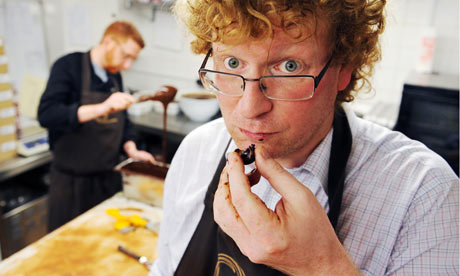
It is a self-evident truth that there are things that don't mix: oil and water; God and Mammon; Spurs and Arsenal. There are those – and I have long been among them – convinced that sweet and savoury are equally antipathetic. Put meats and sweets on the same plate and our brains will not process the information. It's against nature!
In the cramped basement kitchen of his north London shop, the chocolatier Paul A Young has an afternoon to convince me I am wrong, that chocolate is about more than a mid-afternoon sugar hit. I have already cast a scornful eye over the shelves upstairs, silently dismissing the savoury truffles – sage and chestnut, Marmite, port and stilton – as so much novelty. I have wondered what madness would possess a man to make salted caramels. I have remembered a previous, disastrous attempt to make a Mexican mole – a chocolate sauce served with chicken – that ended up as burned bird covered with congealed Dairy Milk.
Young identifies the last five years as a period of change in British attitudes to chocolate. When he opened the first of his two shops, five years or so ago, "it was hard to sell weird and wonderful flavours," he says. But now his port and stilton and his Marmite truffles are among his biggest sellers. However, two shops don't make a national market, and Young bemoans the fact that Britain doesn't have a culture of chocolatiers in the manner of France, Belgium or Spain. He's sad that the cocoa content of Green & Blacks' bars has dropped since Cadbury took the company over; he wishes Thorntons hadn't let its standards slip. And he decries the chocolate snobs who think high-quality bars somehow need to be saved from the mouths of the wider public, for fear of lowering standards. "I'm not one of those people who complains when Tesco puts out a single-origin chocolate bar," he says.
However, I explain to him, I am one of those people who complains every time someone mixes sweet with savoury. So he starts by offering me some of his savoury truffles. The prospect of sage and chestnut does not fill me with joy, but in the mouth it is a revelation – subtle and fragrant, the sage complementing rather than overpowering the chocolate. Port and stilton leaves just the faint taste of cheese after the truffle has gone down – it's unexpectedly delicious. Getting the truffles perfect isn't something you can rattle off in an afternoon, though. "The Marmite one took three months to get right," Young says.
If I am to appreciate chocolate, he insists, I must learn how it's made. And so I find myself, sleeves rolled up, apron on, spreading melted chocolate over a marble slab, a process called tempering. Melting the huge tablets of chocolate, then working them over the slab, before making bars or truffles, breaks down the chemical bonds within it and re-forms them, making the stuff more workable and less brittle. I work at around a fifth of Young's speed – "Hurry! It'll set unless you do it quicker," he warns me – but I don't get any on the floor, and make five flavoured bars, including a salted one that – though I say so myself – is just terrific.
As yet, though, I have been dealing only with sweets. So I arm myself with a copy of Young's book, Adventures in Chocolate, and head home. After the pages and pages of truffle recipes, the reader comes to a section on savouries. They're all things he's cooked at home, he says, not novelties shoved in as an afterthought. I opt for something we have often at home, but with a twist. Into the blender go pine nuts, basil, olive oil, pecorino, lemon zest and juice – and some of Young's chocolate, grated. When the chocolate pesto is served, my wife pronounces it delicious.
A couple of nights later, we have some friends round for supper, and I decide to turn again to chocolate. This time it's in sweet form, but unconventional – a chocolate ravioli, filled with a raspberry and Cointreau compote, sprinkled with grated white chocolate and served with orange-infused double cream.
It's a bit of a struggle: should I just replace a proportion of the flour with the cocoa powder? Should I change the quantity of egg? In fact, adding cocoa powder to the pasta dough mix makes it brittle, and I have to keep adding drops of water to it to keep it workable, but eventually it has enough life in it to run through the rollers, coming out in satisfying sheets of rich brown. And, on the plate, the tartness of the raspberries offsets the chocolatey weight of the pasta to perfection. The whole thing is my own recipe, all my own work, and it makes me feel as smugly proud as any long-forgotten childhood triumph once did.

